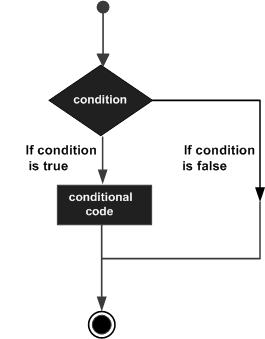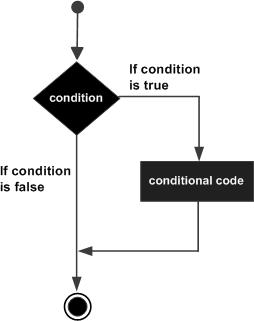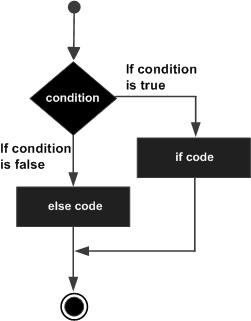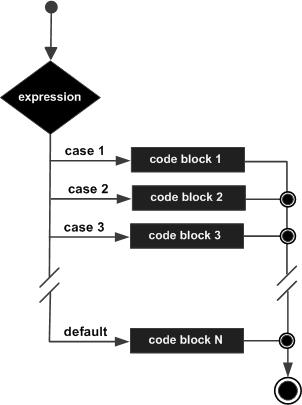初识Tcl(四):Tcl 决策
目录
Tcl决策
决策结构需要程序员指定的一个或多个条件进行评估,或由程序进行测试,如果条件被确定为真以及一条或多条语句,任选的其它语句,如果条件被确定为假则被执行。
以下是在大多数编程语言中找到的典型决策结构的一般形式:

TCL语言使用expr内部命令,因此它为我们声明使用expr的声明不是必需的。
TCL语言提供了以下几种类型的决策语句。
| 语名 | 描述 |
|---|---|
| if语句 | if语句包含一个布尔表达式后跟一个或多个语句。 |
| if...else语句 | if语句可以跟着一个可选的else语句,当else执行时,布尔表达式是假。 |
| 内嵌if语句 | 可以使用一个if 或else if 里面再声明 if 或 else if 语句(S)。 |
| switch语句 | switch语句可以让一个变量对值列表相等进行测试。 |
| 内嵌switch语句 | 可以使用一个switch语句在另一个switch语句中。 |
? : 操作符
我们已经覆盖条件操作符 ? :在前面的章节中可以用它来代替 if ... else语句。以下是它的一般形式:
Exp1 ? Exp2 : Exp3;
计算Exp1,Exp2和Exp3表达式。注意使用和放置。
a的值?表达是确定这样:Exp1计算评估。如果是真的,那么Exp2后进行评估计算,并成为整个的值?表达式。如果计算Exp1是假的,那么Exp3计算它的值变为表达式的值。一个例子如下所示。
-
#!/usr/bin/tclsh
-
-
set a 10;
-
set b [expr $a == 1 ? 20: 30]
-
puts "Value of b is $b\n"
-
set b [expr $a == 10 ? 20: 30]
-
puts "Value of b is $b\n"
当编译和执行上面的程序,将会产生以下结果:
-
Value of b is 30
-
Value of b is 20
Tcl if语句
if语句包含一个布尔表达式后跟一个或多个语句。
语法
Tcl语言的if语句的语法是:
-
if {boolean_expression} {
-
# statement(s) will execute if the boolean expression is true
-
}
如果代码里布尔表达式的值为真,那么if语句块将被执行。如果 if 语句的结束(右大括号后)布尔表达式的值为false,那么第一套代码会被执行。
TCL语言使用expr内部命令,因此它不是明确地使用expr语句声明所需的。
流程图

示例
-
#!/usr/bin/tclsh
-
-
set a 10
-
-
#check the boolean condition using if statement
-
if { $a < 20 } {
-
# if condition is true then print the following
-
puts "a is less than 20"
-
}
-
puts "value of a is : $a"
-
当上述代码被编译和执行时,它产生了以下结果:
-
a is less than 20
-
value of a is : 10
Tcl if...else 语句
if语句可以跟着一个可选的else语句,else语句块执行时,布尔表达式是假的。
语法
在Tcl语言的if ... else语句的语法是:
-
if {boolean_expression} {
-
# statement(s) will execute if the boolean expression is true
-
} else {
-
# statement(s) will execute if the boolean expression is false
-
}
如果布尔表达式的值为true,那么if代码块将被执行,否则else块将被执行。
TCL语言使用expr内部命令,因此它不是明确地使用expr语句所需的。
流程图

示例
-
#!/usr/bin/tclsh
-
-
set a 100
-
-
#check the boolean condition
-
if {$a < 20 } {
-
#if condition is true then print the following
-
puts "a is less than 20"
-
} else {
-
#if condition is false then print the following
-
puts "a is not less than 20"
-
}
-
puts "value of a is : $a"
当上述代码被编译和执行时,它产生了以下结果:
-
a is not less than 20;
-
value of a is : 100
if...else if...else 语句
if语句可以跟着一个可选的else if ... else语句,使用单个if 测试各种条件if...else if 声明是非常有用的。
当使用if , else if , else语句有几点要记住:
-
一个if可以有零或一个else,它必须跟在else if之后。
-
一个if语句可以有零到多个else if,并且它们必须在else之前。
-
一旦一个 else if 成功,任何剩余else if 或else 不会再被测试。
语法
Tcl语言的 if...else if...else语句的语法是:
-
if {boolean_expression 1} {
-
# Executes when the boolean expression 1 is true
-
} elseif {boolean_expression 2} {
-
# Executes when the boolean expression 2 is true
-
} elseif {boolean_expression 3} {
-
# Executes when the boolean expression 3 is true
-
} else {
-
# executes when the none of the above condition is true
-
}
示例
-
#!/usr/bin/tclsh
-
-
set a 100
-
-
#check the boolean condition
-
if { $a == 10 } {
-
# if condition is true then print the following
-
puts "Value of a is 10"
-
} elseif { $a == 20 } {
-
# if else if condition is true
-
puts "Value of a is 20"
-
} elseif { $a == 30 } {
-
# if else if condition is true
-
puts "Value of a is 30"
-
} else {
-
# if none of the conditions is true
-
puts "None of the values is matching"
-
}
-
-
puts "Exact value of a is: $a"
当上述代码被编译和执行时,它产生了以下结果:
-
None of the values is matching
-
Exact value of a is: 100
Tcl 嵌套if语句
Tcl嵌套if-else语句它始终是合法的,这意味着可以使用一个 if 或 else if 在另一 if 或 else if 声明中。
语法
嵌套if语句的语法如下:
-
if { boolean_expression 1 } {
-
# Executes when the boolean expression 1 is true
-
if {boolean_expression 2} {
-
# Executes when the boolean expression 2 is true
-
}
-
}
可以嵌套else if...else 在类似嵌套if语句的方式。
示例
-
#!/usr/bin/tclsh
-
-
set a 100
-
set b 200
-
-
# check the boolean condition
-
if { $a == 100 } {
-
# if condition is true then check the following
-
if { $b == 200 } {
-
#if condition is true then print the following
-
puts "Value of a is 100 and b is 200"
-
}
-
}
-
puts "Exact value of a is : $a"
-
puts "Exact value of b is : $b"
当上述代码被编译和执行时,它产生了以下结果:
-
Value of a is 100 and b is 200
-
Exact value of a is : 100
-
Exact value of b is : 200
Tcl Switch语句
switch语句可以让一个变量值的列表进行相等测试。每个值被称为一个的情况(case),该变量被接通检查每个switch case。
语法
Tcl语言未加引号的switch语句的语法如下:
switch switchingString matchString1 {body1} matchString2 {body2} ... matchStringn {bodyn}
Tcl语言未加引号的switch语句的语法如下:
-
switch switchingString {
-
matchString1 {
-
body1
-
}
-
matchString2 {
-
body2
-
}
-
...
-
matchStringn {
-
bodyn
-
}
-
}
以下规则适用于switch语句:
-
在switch语句中使用的switchingString通过比较matchString使用在不同块之间。
-
在一个switch内可以任何数量matchString块。
-
switch语句可以具有可选默认块,其中必须出现在开关的末尾。缺省情况下,可用于执行任务时没有一个case是真实的。
流程图

例如:未加引号版本
-
#!/usr/bin/tclsh
-
-
set grade C;
-
-
switch $grade A { puts "Well done!" } B { puts "Excellent!" } C { puts "You passed!" } F { puts "Better try again" } default { puts "Invalid grade" }
-
puts "Your grade is $grade"
当上述代码被编译和执行时,它产生了以下结果:
-
You passed!
-
Your grade is C
例如:引用版本
-
#!/usr/bin/tclsh
-
-
set grade B;
-
-
switch $grade {
-
A {
-
puts "Well done!"
-
}
-
B {
-
puts "Excellent!"
-
}
-
-
C {
-
puts "You passed!"
-
}
-
F {
-
puts "Better try again"
-
}
-
default {
-
puts "Invalid grade"
-
}
-
}
-
puts "Your grade is $grade"
当上述代码被编译和执行时,它产生了以下结果:
-
Well done
-
Your grade is B
Tcl嵌套Switch语句
有可能有一个switch作为外开关的语句序列的一部分。即使在内外switch case 的常数包含共同的值,如果没有冲突将出现。
语法
嵌套switch语句的语法如下:
-
switch switchingString {
-
matchString1 {
-
body1
-
switch switchingString {
-
matchString1 {
-
body1
-
}
-
matchString2 {
-
body2
-
}
-
...
-
matchStringn {
-
bodyn
-
}
-
}
-
}
-
matchString2 {
-
body2
-
}
-
...
-
matchStringn {
-
bodyn
-
}
-
}
示例
-
#!/usr/bin/tclsh
-
-
set a 100
-
set b 200
-
-
switch $a {
-
100 {
-
puts "This is part of outer switch"
-
switch $b {
-
200 {
-
puts "This is part of inner switch!"
-
}
-
}
-
}
-
}
-
puts "Exact value of a is : $a"
-
puts "Exact value of a is : $b"
当上述代码被编译和执行时,它产生了以下结果:
-
This is part of outer switch
-
This is part of inner switch!
-
Exact value of a is : 100
-
Exact value of a is : 200
文章来源: reborn.blog.csdn.net,作者:李锐博恩,版权归原作者所有,如需转载,请联系作者。
原文链接:reborn.blog.csdn.net/article/details/85158907
- 点赞
- 收藏
- 关注作者


评论(0)